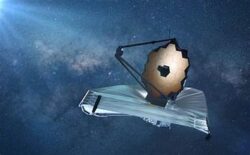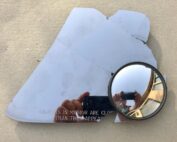In a Galaxy Far, Far Away

VIA SBINSIDER ASTRONOMICAL REPORTER GLORIA DOPPLER | February, 3rd, 2024
It was a dark and stormy night, but nearly 100 people attended the Desert View theater to hear Dr. David Hainline present the latest from the James Webb Space Telescope (JWST) at the SaddleBrooke Star Gazers meeting in January. Dr. Hainline’s effervescent presentation style could not help but get the attendees excited about what is in store for JWST. Dr. Hainline is responsible for the cameras (NIRCam) on board the telescope.
The JWST was conceived before Hubbell was launched and was launched itself in December 2021. It sits on a sun shield with an infrared telescope. This scope can hold 68 giga bytes of data and displays four million points of information.
It takes eight minutes for sunlight to get to our eyes, but what JWST is able to view is light that has traveled 13.6 billion light years through the universe. Viewing through the JWST has allowed the discover of more than 700 galaxies. The ability to see into the past allows our astronomers to explore the history of the universe and the buildup of stars and galaxies from the big bang until today.
There is a five-year mission for JWST, but if they are lucky, they may get 20 years of exploration from this one scope. What has been explored so far is but a grain of sand compared to the totality of the universe.
Here is Dr. Hainline’s description of his research: My research explores the evolutionary link between galaxies and their central supermassive black holes. Specifically, I examine “active galactic nuclei“, or AGNs, where material falling onto the black hole produces an enormous amount of light across the entire electromagnetic spectrum. By examining “obscured” AGNs, where central dust blocks a large amount of this AGN emission, I can look at their host galaxies to explore how the AGN emission can affect star-formation and gas dynamics.
To explore AGN host galaxies, I focus on optical and near-infrared spectroscopy, where I can examine the light as a function of wavelength to see how AGNs can ionize and disturb gas. My graduate thesis focused on AGNs at high redshift, while my postdoctoral research has centered on the search for nearby obscured quasars.
Go to this link to see the JWST Advanced Deep Extragalactic Survey















